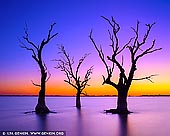Lake Bonney
Riverland, South Australia, Australia
Lake Bonney is a freshwater lake located in the Riverland region of South Australia. The lake is fed and drained by the River Murray. The town of Barmera is located on its shores.
The lake was discovered by Europeans on 12 March 1838, when encountered by the overlanding party of Joseph Hawdon and Charles Bonney, who were the first to drove livestock from New South Wales to Adelaide. Hawdon named the lake that day after Bonney, while recording that the local indigenous people named it 'Nookampka'. At that time it was a fine sheet of water, but was dried out and muddy three years later in 1841 when the police expedition led by Thomas O'Halloran passed by on its way to rescue other overlanders at the Rufus River.
When Charles Sturt passed by in 1844 on his expedition into the interior of Australia, he surveyed Lake Bonney for the first time, as well as the creek connecting it to the River Murray. James Collins Hawker, then residing at Moorundie, assisted Sturt’s surveyor Poole. In appreciation, on 2 September 1844 Sturt named the creek Hawkers Creek, but it was never officially adopted and is known as Chambers Creek.
Pioneering settlers sometimes cropped the dry lake bed in times of low river flows. In 2007, to conserve water in the Murray system, a regulator was installed. The regulator cut the lake from the river system and the lakes' level dropped to its lowest level since 1914 and salinity increased markedly with loss of wildlife and also recreational water activities. The regulator was removed in December 2010 and this, with wet summer and winter rains restored it to normal levels by April 2011.
Name duplication within South Australia for both the lake and its feeder creek sometimes causes confusion, because there is also Lake Bonney located in the Limestone Coast region, and Chambers Creek in the Flinders Ranges.
Since the 1950s the lake has been a popular venue for holidaymakers, being used for a wide range of water sports, particularly sailing and water-skiing.
About the Artist
I'm Ilya Genkin - an internationally recognised Australian landscape and fine art photographer based in Sydney. My passion for capturing the beauty of nature and our world translates into striking photographic prints that bring life, emotion, and inspiration to any space. From tranquil seascapes to dramatic mountainscapes, each image is a reflection of my vision and dedication to the art of photography.
Fine Art Landscape Photography Prints
Explore my extensive collection of fine art prints - crafted with the highest-quality materials to suit every style and budget. Whether you're looking for a luxurious, ready-to-hang piece or a beautifully printed work to frame yourself, each photograph is available in several premium formats: Gallery-quality Fine Art Paper Prints - ready for framing, and Professional Canvas Prints - classic and timeless texture.
Each artwork is meticulously printed and made-to-order to ensure you receive a piece that elevates your home, office, or commercial space.
Artworks for Interior Designers, Home Stylists, and Architects
I collaborate with interior designers, home stylists, and architects to create bespoke wall art tailored to your project's aesthetic and colour palette. Prints can be customised and sized to complement your space perfectly. All pieces are made-to-order, and pricing varies based on size, quantity, and shipping.
Contact me to discuss your project and request a personalised quote.
Why Choose Ilya Genkin Photography?
By choosing my work, you're not just acquiring exceptional art - you're supporting an independent Australian artist and contributing to a vibrant local creative community. Every purchase directly helps sustain and grow this craft, bringing authentic and meaningful art into your life.
Request a free mockup to see how a chosen photograph will look in your space before you buy.
Start your journey today - browse the galleries and transform your walls with fine art photography.
Fine Art Landscape Photography
Information
Photography Guides
Online Store Opens 24/7
Email:
Phone: +61 (0) 421 055 613
Crafted with care for the planet - using sustainable materials and eco-friendly packaging.
Ilya Genkin Photography acknowledges the Traditional Custodians of the land on which we operate, live and gather as employees, and recognise their continuing connection to land, water and community. We pay respect to Elders past, present and emerging.



